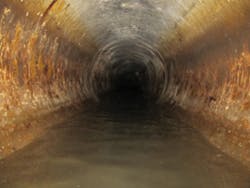The town of Palm Beach, FL, is located on a long, narrow barrier island 65 miles north of Miami and is well known for its many multimillion-dollar mansions. The expensive real estate and the ever-present saltwater are major complications for the Public Works Department; saltwater corrodes everything, and digging things up for repair is always costly. Therefore, maintenance and trenchless methods are high priorities, and the department is always alert for new technologies.
As part of a larger project, Palm Beach recently cleaned and rehabilitated 225 feet of 60-inch reinforced concrete pipe (RCP) storm sewer that was about 30 years old. “There were basically two access points,” says Brandon Depicciotto, owner of Underground Services of America, based in West Palm Beach, “the pump room, and the outlet in the Intracoastal Waterway.” Depicciotto was working from the intracoastal side, and was using two relatively new technologies: a spray-on lining called COR+ROC, and an application method called Centri-Pipe. Both are made by AP/M Permaform of Johnston, IA, a firm that specializes in trenchless solutions. “I’ve used similar products and methods on manholes,” explains Depicciotto, “but this was the first time on horizontal pipe.”
COR+ROC is a two-component, high-strength polymer gel intended for one-step structural lining and corrosion protection. It has several advantages that made it especially well suited for the Palm Beach project. It doesn’t sag, so it can be used on horizontal pipe. It’s moisture insensitive and bonds well to wet surfaces, so the sewer’s constant coastal dampness wouldn’t be a problem. And, when set, COR+ROC is not only structural, adding significant strength to rehabilitated pipe, but also works much like epoxy coatings to prevent corrosion from saltwater. And Depicciotto says it’s relatively easy to work with: “I’m used to working with epoxies,” he says, “and if you’re used to epoxies you can work with COR+ROC. I like it; it has incredible bond strength and sticks to anything, it’s user-friendly, and cleanup wasn’t hard.”
To dewater the system, Depicciotto devised a system of two temporary barrier walls and pumps that let him work at low tide. After using scraping and high-pressure washing to remove oysters and other buildup, he was ready to apply COR+ROC with Centri-Pipe. “The pipe actually looked pretty good after cleaning,” says Depicciotto, “which was good, of course; it meant we didn’t have to repair gaps before application and that we can stop corrosion before it happens. With the COR+ROC in place to protect against salt damage, this storm sewer should be trouble-free for decades.”
Centri-Pipe is a spincasting system that was pioneered in manholes–its use in horizontal pipe is relatively new. It doesn’t require backhoes or big staging areas (which weren’t available on the Palm Beach project), and it works on pipe up to 120 inches in diameter. Basically, the spincaster is inserted into pipe and withdrawn at a calculated speed while a computer-controlled motor pumps applies thin layers of structural grout or epoxy mortar. The finished product is smooth and tightly bonded, and it doesn’t significantly reduce the pipe’s inner diameter or flow.
Compared to other methods, like sliplining or cured-in-place pipe, Centri-Pipe and COR+ROC offer several advantages: minimal flow reduction, added structural strength, minimal staging area, and speed. A pilot project by the Minnesota Department of Transportation found that it was also competitively priced.
Fixing a pipe that “looked pretty good” might seem a little
too efficient in these budget-conscious times, but the Palm Beach Public Works Department feels it was a good value. By strengthening the pipe and preventing corrosion, the department has eliminated expensive repair for decades. Sometimes it pays to use a new technology, and to fix a pipe before it’s broken.







